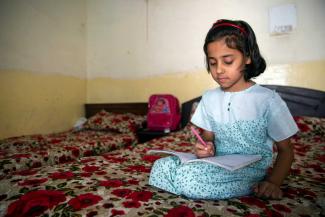Poverty
School closures in pandemic showed multidimensional poverty

Poverty is typically defined in financial terms. The World Bank defines those living on less than the purchasing power of $ 1.90 per day as extremely poor, while the poverty line for a lower-middle income is $ 3.20 per day. Such monetary notions of poverty are based on estimates of the cost of goods and services required to meet the basic subsistence needs.
But not all goods and services can be obtained through markets, as the World Bank acknowledges. Some require large public investments and government spending. That includes physical and social infrastructures such as the power grid, the sewerage system, schools and health care. Deficiencies in fields like this compound deprivation. A depressing global pattern is that children tend to fare worse than adults, and female persons suffer more than their male counterparts. It also matters that poverty affects different age groups in different ways. Children, for example, are not supposed to be earning a living on their own, and measures of families’ purchasing power only offer a partial assessment at best. Poverty is therefore best understood as a multidimensional phenomenon, which goes beyond income and consumption. Other aspects are critical for well-being too.
SDGs tackle a host of poverty-related issues
The first UN Sustainable Development Goal (SDG1) is therefore to end poverty “in all its forms everywhere”. Accordingly, the SDG agenda tackles a multitude of related issues, from good health (SDG3) and quality education (SDG4) to labour conditions (SDG8), infrastructure (SDG9) or environmental hazards (SDG11).
According to the UN Development Programme (UNDP), some 1.3 billion people in 101 countries suffered multidimensional poverty in 2019. Half of them were below the age of 18, and 85 % of these young persons lived either in South Asia or sub-Saharan Africa.
Multidimensional poverty tends to affect more people than poverty measured in strictly financial terms. According to the UNDP’s 2019 index for multidimensional poverty, for example, 39 % of Pakistanis suffered this kind of poverty, while only 34 % had a purchasing power below $ 3.20 per head and day. It fits the picture according to a study conducted by UNICEF, the UN Children’s Fund, in Pakistan about half of all kids below the age of 18 suffered at least one severe deprivation. For example, they lacked access to school, health care or safe drinking water. Many of them belonged to families that were not financially poor. The study found deprivation to be worst in regard to informational needs.
Increasing child poverty
Since 2019, moreover, UNICEF has reported a 10 % increase of global child poverty. The number of children living in multidimensional poverty is said to have soared to approximately 1.2 billion in 2020.
Things were especially bad in regard to education. As schools closed down, at least one third of the world’s schoolchildren were denied any kind of formal lessons. The main reason was that they lacked digital equipment. Rural areas were affected in particular. Low connectivity and unfavourable student-teacher ratios obviously compounded the problems.
There were gender angles moreover. In male-dominated societies, sons tended to get priority access to mobile devices, while daughters were denied the safe public spaces that schools offer and their development benefits from in normal times (Ipsita Basu has discussed the Indian scenario on www.dandc.eu). According to UNICEF, only up to seven percent of students could use the internet in South Asia and Sub-Saharan Africa.
Governments adopted stopgap measures. For example, they opted for TV or radio lessons where digital technology was only insufficiently available. While personal interaction is possible in digitised classrooms, students following broadcasts have no such opportunity. That compounded the problem that poor parents are typically not in a good position to support their offspring’s learning. In Pakistan, a TV channel called Tele-School offered an-hour-a-day educational programming for every level of education. BBC contributor Mehreen Zahra-Malik called the minority who benefited from digital platforms the “lucky ones”.
Digital poverty
The pandemic has thus highlighted the digital divide that exists both within and between nations. UNICEF found a clear association between a country’s gross national income per capita and the percentage of students with access to digital classrooms. The notion of “digital poverty”, which predates Covid-19, has thus been reinforced. The Digital Poverty Alliance, a non-governmental initiative launched in Britain in 2021, defines it as “the inability to interact with the online world fully, when, where and how an individual needs to”. The Alliance insists that digital exclusion exacerbates existing inequalities in society and lead to new inequalities.
Once again, there is a considerable gender divide. Both access to digital devices and digital literacy tend to be less developed among women and girls, after all (for the example of Pakistan, see Sundus Saleemi on www.dandc.eu).
A crucial lesson of the Covid-19 crisis is thus that every kind of digital divide deserves public attention. The SDG motto is to leave no one behind – and that includes everyone who is still deprived of the opportunities that modern information and communication technology offers. Developing countries must build appropriate digital infrastructure and promote digital literacy. That is a message policymakers must heed at national levels, and international agencies should support related efforts.
Mahwish Gul is a consultant from Pakistan who specialises in development management. She lives in Nairobi.
mahwish.gul@gmail.com














